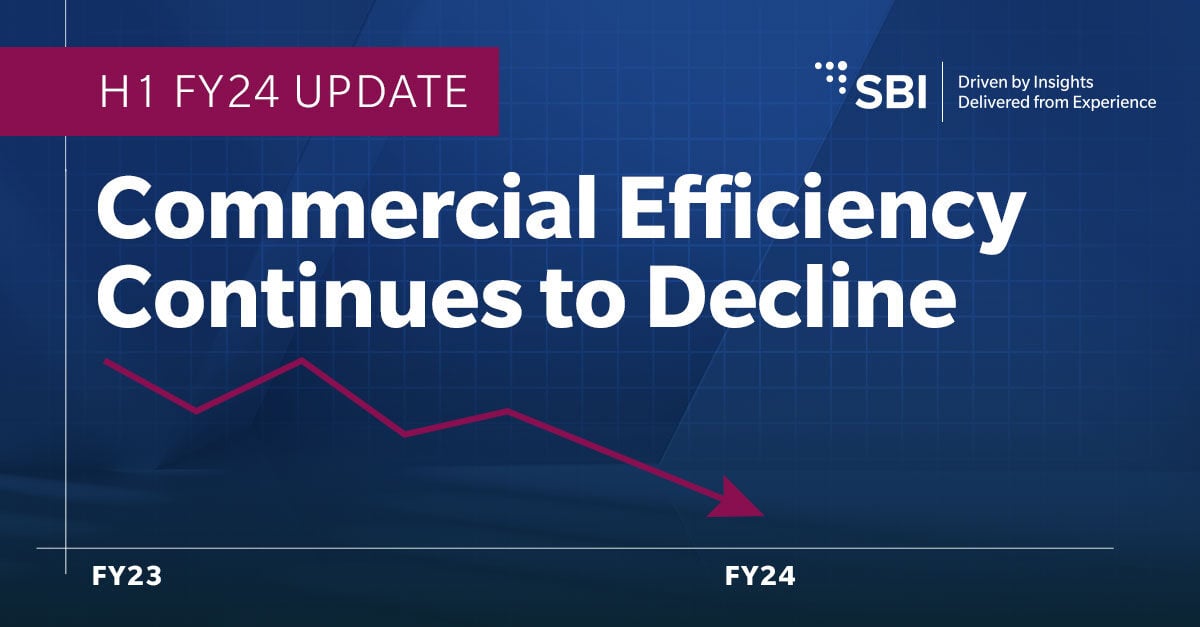H1 FY24 Update: GTM Efficiency Continues to Decline


Many companies found themselves in a worst of both worlds situation in 2023, struggling to deliver growth while managing a continuing increase in go-to-market expense. Commercial efficiency is eroding. As we look at early returns from 2024, there is little to suggest the tide has turned.
Earlier this year, SBI published a study on GTM efficiency at 237 SaaS, IT, and commercial services firms from FY21-FY23. With new data available from 36 of those companies reporting FY24 results, we’ve taken a look at year-over-year performance and how leadership teams are managing their efficiency challenges as they seek to unlock profitable growth.
The new rule is "Rule of 14."
Of the 36 companies in our original set that have reported FY24 results so far, the data is eerily familiar. Revenue growth remains flat at a modest 10%, while EBITDA margins linger at 4.2%. These numbers mirror what we saw in FY23, with companies continuing to perform at a median "Rule of 14" level.

Despite efforts to recalibrate go-to-market (GTM) strategies in FY23, commercial efficiency remains under pressure in FY24 as higher costs and high interest rates continue to stifle demand and weigh on revenue performance. The inability to push beyond these modest results suggests that companies need to do more than just tweak their GTM strategies. Without a major shift in execution, these companies risked another year of slow growth and missed targets.
Sales and Marketing expenses are steady after a significant increase.
One notable bright spot for the 36 commercial teams reporting in FY24 is that sales and marketing expenses have begun to stabilize. After climbing dramatically over the past few years—reaching 46% above 2020 levels in FY23—median sales and marketing expenses fell by 4% in FY24. However, it’s important to keep this in context. Across the entire set of 237 companies from our previous research, the median increase in sales and marketing expenses was even more dramatic, surging by as much as 68% above 2020 levels in FY23. This suggests that while some companies may be pulling back on spending, many others may still be struggling with the burden of inflated costs.

What’s clear is that any adjustments to spending have yet to translate into meaningful gains in performance, leaving many companies in a precarious position where profit and growth are still at odds. With EBITDA margins still tight, the reality is that many organizations are simply out of room to increase their budgets without eroding profitability. Even as companies trim expenses, the underlying inefficiencies in their GTM operations will persist unchecked. Without finding new ways to increase the productivity of existing resources, many companies will continue to see their profit margins squeezed by rising costs.
GTM efficiency continues to decline.
Given stubbornly high costs and the uncertainty that still remains in the market, it’s not surprising that companies continued to struggle with GTM efficiency in FY24. Commercial teams returned just $0.31 in revenue growth for every dollar spent on sales and marketing—a 16% decline from FY23.

For companies grappling with this efficiency drop, the implications are stark. With demand remaining soft and sales teams already streamlined to operate more efficiently, there is little flexibility left for further cuts. Instead, companies must focus on maximizing returns from their existing commercial investments. As the gap between spending and results widens, the path to profitability will require not just careful investment but a focus on driving productivity with the team in place.
Act now to improve commercial efficiency.
Given these ongoing challenges, improving GTM efficiency should be at the forefront of every CEO and CFO’s mind. As we outlined in our previous whitepaper, the key to unlocking profitable growth lies in optimizing GTM operations. To summarize our core recommendations:
- Identify and focus on the strongest-fit accounts to reduce wasted efforts and drive higher returns.
- Refocus GTM investments on existing customer channels to capitalize on expansion opportunities within the current base.
- Clarify roles and responsibilities for retention efforts to ensure consistent execution across customer segments.
- Rationalize revenue technology investments to create a coherent fact base for data-driven decision-making.
For more in-depth analysis and a deeper dive into these strategies, download our full research report here. Now is the time to focus on commercial efficiency, align your team’s efforts, and drive the results needed to navigate the challenges of FY24 and beyond.